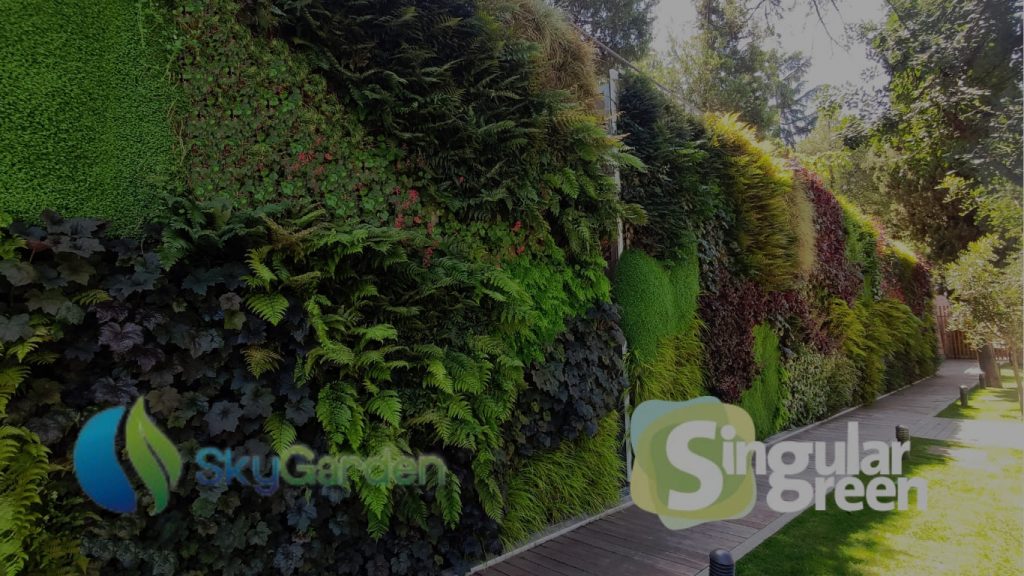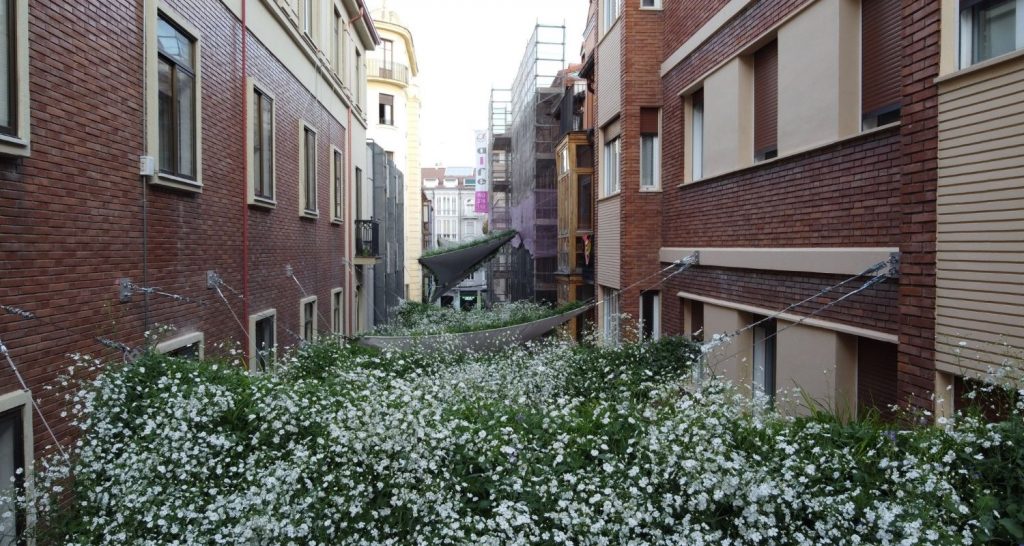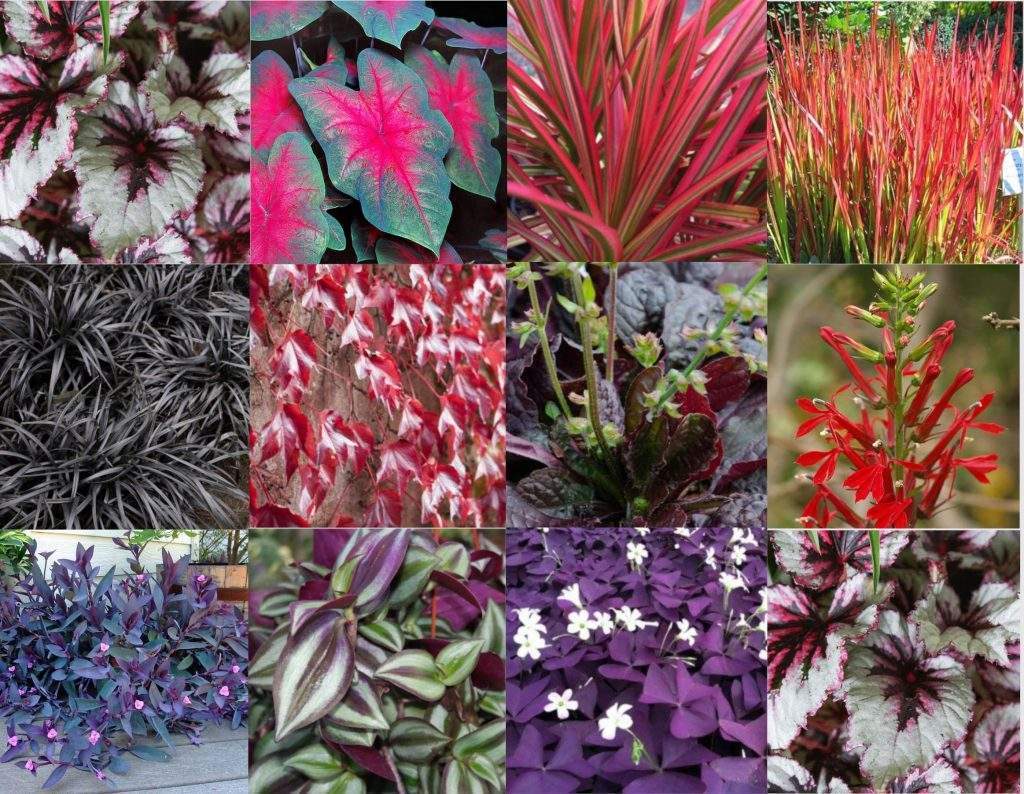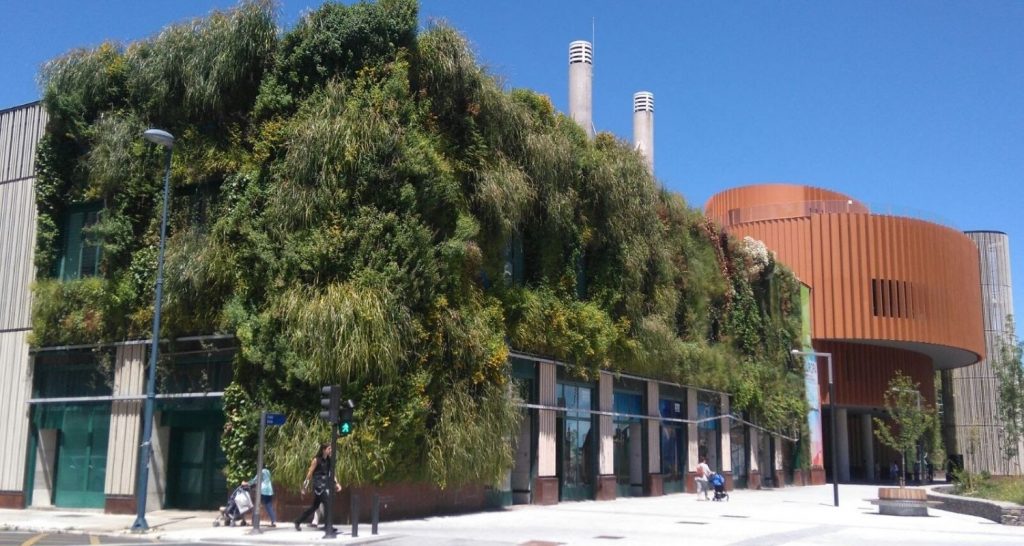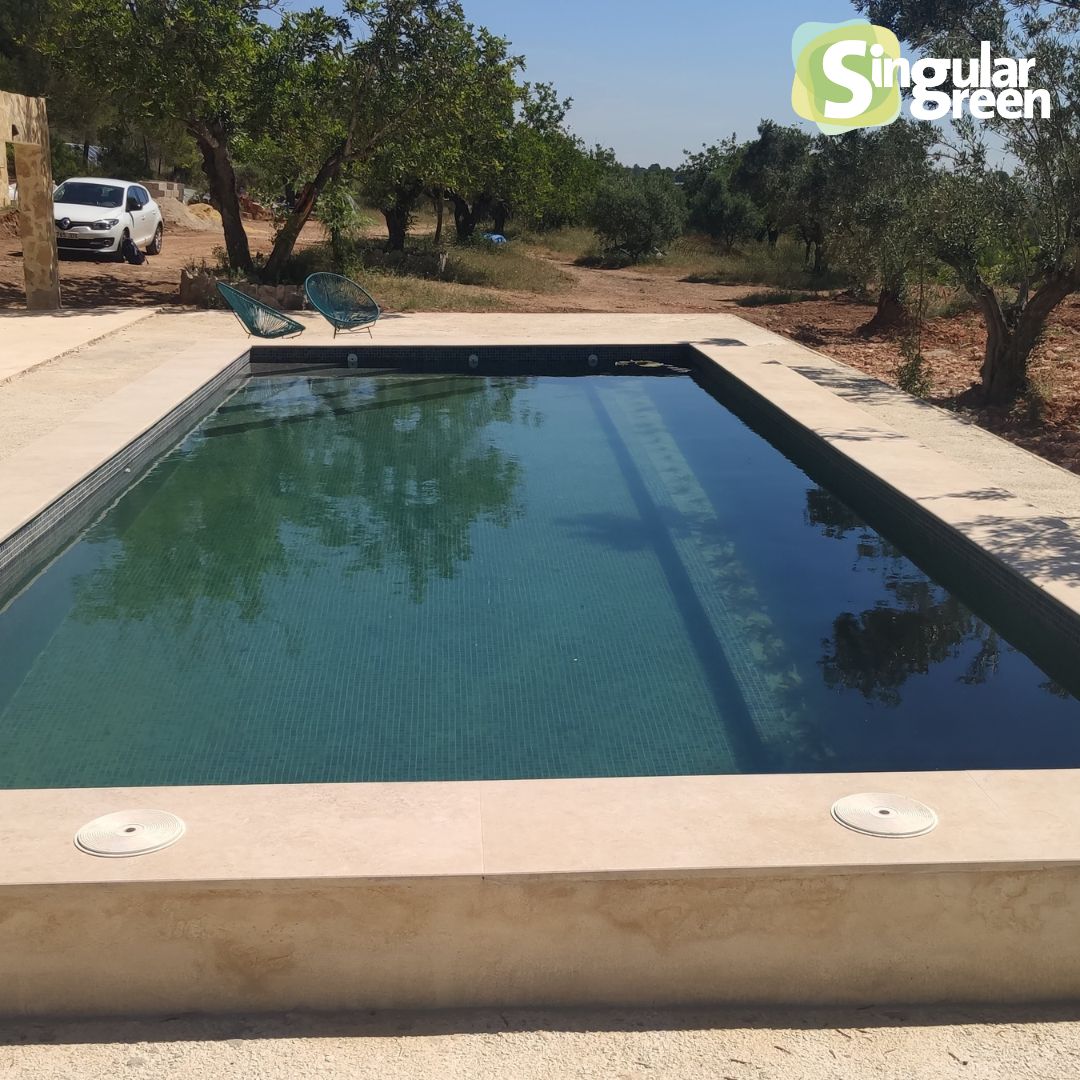Aren’t you tired of always seeing green as the predominant color in your vertical gardens? In this article, we want to show you that there are more options. In this case, we want to talk about red and purple-leaf plants, which, when introduced in vertical gardens, or even in pots in our homes, can create exquisite combinations with green, moving away from monochrome.
Parthenocissus tricuspidata “Veitchii” or Boston Ivy
It is a fast-growing Asian plant (China and Japan) that is a climbing shrub that can reach a length of 8 to 10 meters.
Leaves:
Its leaves are deciduous and come in different shades, but they all turn reddish in autumn when they fall. Additionally, they have variable morphology (round, heart-shaped, serrated, divided or three-lobed). Its tendrils end in suction cups and adhere to the surface.
Plant Needs:
Watering:
- It is preferable that the soil is well-drained to favor reddish colorations. When we install these plants in our vertical gardens, watering is not a problem, as it has a telecontrol system, which is programmed to perform several waterings during the day for an estimated time. The frequency and duration of these waterings are determined by the characteristics of the garden, such as its location.
Light:
- In terms of light, it tolerates both shade and sun, but the sun helps develop those reddish colorations.
Temperature:
- In terms of temperature, this type of plant is very versatile and can withstand both high heat and cold temperatures.
Pruning:
- There is no stipulated time for pruning, as it is a climber, it should be pruned when it is considered that its growth is excessive and its development needs to be oriented.
Red Lobelia (Lobelia cardinalis)
This species originates from North America and is a herbaceous plant that can reach a height of 40cm to 2m.
Leaves:
Its leaves are evergreen and vary in morphology (oval, lanceolate with toothed margins, pointed). Its stem is erect and can be green or purple in color. This plant is well known for its flowers, which appear in bright red clusters, although they can also be pink or white in some cases.
Plant Needs:
Watering:
- The soil must be well-drained. However, as mentioned earlier, when introduced into a vertical garden, there is total control over this aspect through the telecontrol system.
Light:
- This plant needs to be located in areas of sun and semi-shade to achieve successful growth.
Temperature:
- It can withstand warm temperatures.
Pruning:
- This plant does not require many prunings, only the removal of dry or damaged branches.
Purple shamrock (Oxalis regnellii atropurpurea)
It is a species from tropical regions of Brazil. It is an herbaceous and rhizomatous plant. Its stems come from a bulb and are thin, green and can reach up to 20 or 30 centimeters in height.
Leaves:
It is composed of a three-lobed leaf in dark purple or purple color. In addition, during periods like spring it can produce small white or pink flowers.
Plant Needs:
Watering:
- It requires regular watering and well-draining soil. In the case of vertical gardens, this can be solved by installing a telecontrol system.
Luz:
- This type of plant needs good but indirect lighting, the more light its leaves receive, the better they will unfold.
Temperatura:
- These types of plants can tolerate a temperate temperature that ranges between 5 and 30 degrees, therefore, they do not withstand frost.
Poda:
- The only maintenance required is the removal of damaged foliage.
Salvia lirata (Salvia lyrata)
It is a species native to the eastern United States.
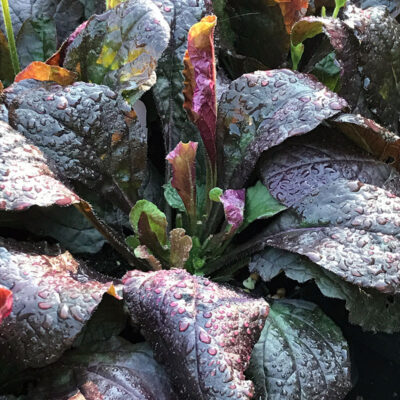
Leaves:
It is a perennial herbaceous plant that forms a rosette of leaves of approximately 20 cm, with irregular, lobed or cut margins. The color of the leaves is burgundy, which turns into dark purple in summer and then red in autumn.
Plant Needs:
Watering:
- The soil moisture level must be constant but not excessive, as it does not tolerate waterlogging, so the area must be well drained. In vertical gardens, this is achieved perfectly with the use of telecontrol.
Light:
- It is a plant that requires a lot of light, so it can only be placed in areas with direct sun exposure to promote its normal growth.
Temperature:
- It usually develops well with warm temperatures.
Prunning:
- Only remove damaged leaves..
Tradescantia, also known as Purple Heart (Tradescantia pallida)
Originally from Mexico, this is a fast-growing perennial herbaceous plant that can reach a height of 30 to 40cm, with long, trailing stems.
Leaves:
Its leaves are elongated, thick, pointed, and can measure about ten centimeters long. They are purple, which makes it a very decorative plant. It also produces small pink flowers with three petals in the spring and summer months.
Plant Needs:
Watering:
- This plant adapts perfectly to dry climates and, therefore, does not usually require abundant watering. In fact, overwatering is counterproductive for them. It is important to ensure that the plant has good drainage.
Light:
- Light is essential for the fruitful development of this plant. A lack of light can cause the plant to become sick. However, it is important not to confuse light with direct sun exposure, as a gradual exposure to the sun could cause the leaves to lose their color.
Temperature:
- This type of plant has a greater affinity for warmth, so it should be avoided exposure to temperatures lower than 12-15 degrees. This does not mean that these plants cannot develop in cold areas, but they will need to be indoors to prevent them from freezing.
Pruning:
- Tradescantia has a great capacity for growth, so it should be pruned at least once a year to ensure that subsequent growth is more vigorous and provides greater height and width. Alternatively, small pruning can be done more frequently to control its growth.
Tradescantia (Tradescantia zebrina)
Originating from the southeastern United States, this is a herbaceous, trailing plant with weak stems that can reach a length of 30-50cm and is of a purple color.
Leaves:
The leaves are tricolor, featuring two white bands surrounded by green on the center and edges, with a purple back. The leaves have a pointed shape and are attached to the rounded base of the stem. Its flowers are small, with three pink petals.
Plant Needs:
Watering:
- These plants do not require excessive watering and can withstand dry climates and short periods of drought.
Light:
- They require well-lit locations, especially for the development of their coloration. However, direct exposure to the sun should be avoided.
Temperature:
- These plants develop favorably in high temperatures, and it is recommended that temperatures do not drop below 12ºC, although they can tolerate lower temperatures of up to around 5ºC. If located in very cold areas, it is advisable to keep them indoors.
Prunning:
- This plant requires regular trimming to control its growth.
Grasses and ground covers.
Grass Red Baron (Imperata cylindrica «Red Baron»)
As its name suggests, it is a plant from Japan. It is a herbaceous species that belongs to the grass family and can grow up to 50cm.
Leaves:
Its leaves are evergreen, and their color starts with a light green on the lower part, evolving to red on the upper part. In spring, it emerges with green leaves and red tips. Over time, the red color expands throughout almost the entire leaf, becoming a deep red.
Plant Needs:
Watering:
- It should be located in well-drained areas, and in the case of vertical gardens, watering will be programmed in time and duration, taking into account the needs of the garden.
Light:
- It can be placed in areas with sun or partial shade, but direct sun exposure should be avoided, especially during periods of high temperatures.
Temperature:
- It can withstand low temperatures, so it can be installed in gardens in cold areas since it can withstand frost.
Pruning:
- It does not require excessive pruning, only the removal of those leaves that are in poor condition.
Black Mondo Grass (Ophiopogon planiscapus «niger»)
It is native to temperate regions of southern Asia, mainly Japan, China, and Korea, where it grows on open and woody slopes. It is a perennial and herbaceous plant about 20 cm tall, mainly used for decoration.
Leaves:
Its leaves are elongated and thin, with a purple almost black color. Its stems stand out above the foliage and have clusters of small bell-shaped pink flowers.
Plant Needs:
Watering:
- It needs well-drained soils that can be achieved with the irrigation programming of the vertical garden.
Ligth:
- It grows well in both sunny or semi-shaded locations. Excessive exposure to direct sunlight can cause the leaves to burn.
Temperature:
- It can tolerate small periods of drought and even withstand quite low cold temperatures and even frost.
Pruning:
- It does not require extreme pruning, only the removal of any leaves that are in poor condition.
Indoor Plants
Red-leaf Begonia (Begonia rex)
Leaves:
Native to tropical areas, this plant has large, colorful leaves on the top and red, hairy undersides. The leaves have a heart shape and their edges can be toothed, oval, and more. The flowers are relatively insignificant.
Plant Needs:
Watering:
- This plant requires moist soil as it transpires a lot of water. However, this does not mean that there should be excess water or waterlogging, as it can harm the plant.
Light:
- This plant requires light, but it should not be directly exposed to sunlight.
Temperatura:
- As an indoor plant, it does not require too much heat. Its ideal temperature ranges from 13-20ºC, and excessive heat can affect the plant’s appearance.
Pruning:
- This plant does not require much pruning, only the removal of damaged leaves.
Caladio (Caladium bicolor)
Native to South America, these plants can reach a length of 40 to 90 cm. There are about 1000 variations of this plant.
Leaves:
They have arrow-shaped leaves of various shades: white, pink, red, and green. They can reach up to 28 cm in height. As for the flowers, they are very small and insignificant but numerous.
Plant Needs:
Watering:
- As a tropical plant, it needs some humidity, watering regularly but without overdoing it as excessive water can cause root rot.
Light:
- It is a plant that needs abundant light but avoiding direct sunlight.
Temperature:
- These plants have a greater affinity for high temperatures between 15ºC and 20ºC, and their growth is fruitful. It is important to take into account sudden changes in temperature, frost, and cold shocks as they could end the plant.
Pruning:
- It does not require much pruning, only the removal of affected leaves.
Drácena «Colorama» (Dracaena marginata «Colorama»)
It is a plant of tropical origin.
Leaves:
- Its leaves are thin and elongated with prominent reddish borders.
Plant Needs:
Watering:
- It is a plant that tolerates short periods of drought at certain times of the year, and it does not require much watering.
Light:
- It needs constant light, but it is important not to receive direct sunlight, and it is quite tolerant of semi-shaded places.
Temperature:
- This type of plant develops best in warm areas, so the ideal temperature ranges between 15ºC and 26ºC.
Pruning:
- Pruning is carried out more for ornamental purposes than for the needs of the plant.
Cordyline fruticosa “Rubra”
The plant has thick, elongated and curved leaves that are green on the edges and have a red central vein. It can grow up to one meter tall.
PLANTS NEEDS:
Watering:
- The plant needs well-drained and moist soil, which is not an issue in vertical gardens as they are controlled by a remote control system.
Light:
- The plant requires abundant light to maintain the red color of its leaves, but it can also be placed in areas of partial shade. Direct exposure to the sun should be avoided.
Temperature:
- The plant thrives in tropical and subtropical climates, so it prefers warm temperatures between 15°C and 25°C.
Pruning:
- The plant does not grow excessively, so it only needs moderate pruning.
Hypoestes phyllostachya
This plant is a perennial. Its oval-shaped leaves have pointed tips and are green with spots of cream, red, or pink. The flowers are small and have little ornamental value.
Plant Needs:
Watering:
- The plant needs well-drained soil that is kept moist.
Light:
- The plant needs to be placed in well-lit areas but not in direct sunlight, as it can lose its red coloration if it doesn’t receive enough light.
Temperature:
- The plant is sensitive to cold and should not be placed in areas with temperatures below 10°C.
Pruning:
- The plant should be pruned a couple of times a year to maintain the garden’s shape.
Codiaeum variegatum
This perennial plant has leaves with various shapes such as lobed, oval, three-lobed, or lanceolate, with colors that range from green, white, pink, red, yellow, to brown. The flowers are small and have little ornamental value.
Plant Needs:
Watering:
- The watering frequency varies depending on the season, but in the case of vertical gardens, it is controlled by a remote control system.
Light:
- The plant needs abundant light but should not be exposed to direct sunlight to avoid losing its different colorations and burning its leaves.
Temperature:
- The plant needs to be placed in environments with temperatures between 16°C and 25°C.
Pruning:
- The plant only needs to be pruned as necessary to maintain the desired shape of the vertical garden.
Stromanthe sanguinea
The leaves grow in a fan shape, with new leaves emerging from the previous ones. They are elongated and have pink, reddish, cream, and green colors. They are highly decorative plants.
Plant Needs:
Watering:
- It needs to keep the soil well-drained and moist, but not excessively.
Light:
- It cannot tolerate direct sunlight, so it is best to locate it in shady or semi-shaded areas.
Temperature:
- It should not be below 15ºC. Also, sudden temperature changes can damage its leaves.
Pruning:
- It will require various pruning to maintain the desired shape of the vertical garden.
Syngonium podophyllum “Pink”
It is a perennial plant with arrow-shaped leaves and pink color.
Plant Needs:
Watering:
- It needs well-drained and moist spaces.
Light:
- They cannot be exposed to direct sunlight. These plants thrive in low to medium light environments and prosper with bright, indirect light. They do not like exposure to direct sunlight.
Temperature:
- Al ser una planta que se desarrolla en zonas tropicales o subtropicales es afín a temperaturas cálidas, aquellas que oscilan entre los 18ºC y 25ºC y en las que no se producen cambios bruscos.
Pruning:
- It is a plant that needs to be pruned more frequently if located in vertical gardens since it is a climbing plant that develops much more and could hinder the growth of other plants in the vertical garden.
Plectranthus scutellarioides
It is a perennial herbaceous species with green stems that can reach 90 cm. Its leaves are variable in size, color, and shape. They are usually oval-shaped with toothed edges and a velvety upper part. Its flowers appear in the form of small clusters of violet or blue tones, which do not stand out too much.
Plant Needs:
Watering:
- It is not a particularly demanding plant with soil, it just needs to be well-drained and with constant moisture.
Light:
- It is a plant that can withstand exposure to full sun, but filtered sunlight or semi-shaded areas are preferable.
Temperature:
- It usually thrives in warm places where there are no sudden temperature variations, ranging from 18ºC to 25ºC.
Pruning:
- Regarding pruning, it is not a plant that develops excessively, so it only needs small cuts to maintain the shape of the vertical garden.
As you have seen, these types of plants do not require very specific or complicated care. Therefore, why not introduce these species more frequently in vertical gardens or in pots in different spaces?
If you want to learn more about vertical gardens and green roofs, do not hesitate to take our online courses.

